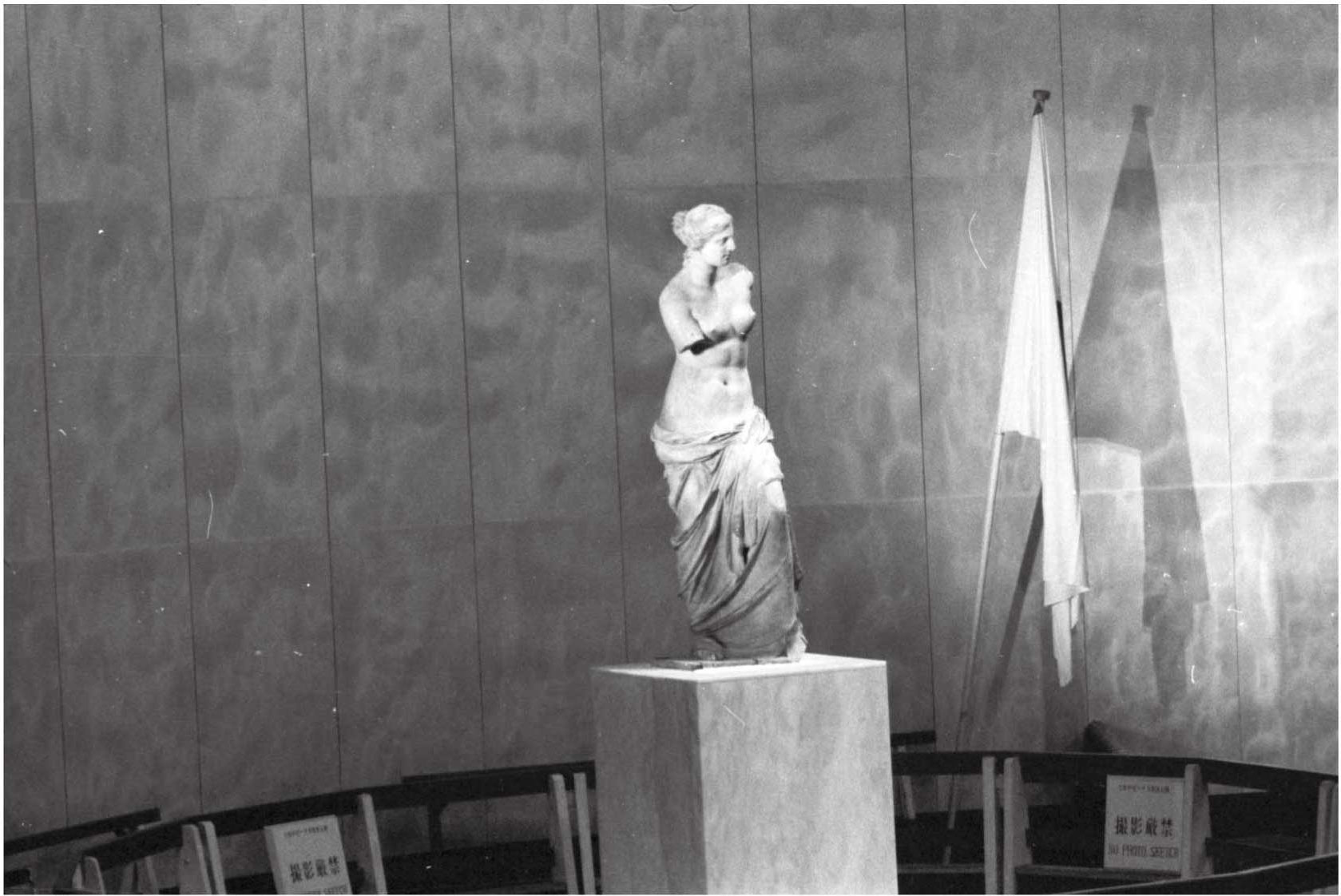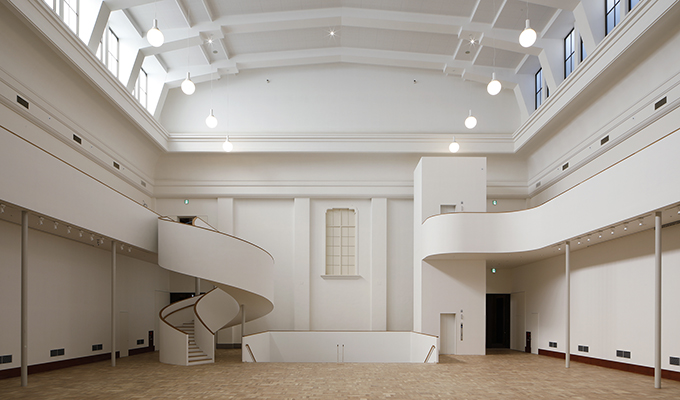The Museum opened in 1933 as the Kyoto Enthronement Memorial Museum of Art in Kyoto’s Okazaki district, itself an expression of the city’s modern trends at the time. The establishment of the Museum owes much to the generous support of many local citizens.
It was renamed the Kyoto Municipal Museum of Art after World War II.As Japan’s oldest public art museum that is housed in its original architecture, its classical visage standing against the backdrop of Higashiyama has been highly appreciated for 85 years.
The innovative concepts of two leading Japanese architects, Aoki Jun and Nishizawa Tezzo, for the Museum renewal project introduced new designs while preserving original elements, thus allowing for a fusion of old and new to create a fresh image for the Museum.
We invite you to enjoy the new Kyoto City KYOCERA Museum of Art.
2020 SPRING
A New Chapter in Kyoto’s History of Culture and Art
HISTORY
HISTORY 1933-2015
1933
Kyoto Enthronement Memorial Museum of Art opens. The two-storey Imperial Crown Style steel-framed reinforced concrete structure was built with support from Kansai business and art sectors, and Kyoto citizens to commemorate the 1928 enthronement ceremonies. The Museum design was by architect Maeda Kenjiro who gained the commission through open competition calling for “a basic Japonica style of architecture around the entire periphery.” The inaugural exhibition was the 14th Teiten Exhibition organized by the Imperial Fine Art Academy.

1934
The Kyoto Enthronement Memorial Museum of Art Exhibition, with many works donated by the Committee for the Celebration of the Enthronement.
1935
The 1st Art Exhibition (Shiten,) sponsored by the city of Kyoto and organized through open submissions of the general public.

1944
Museum activities continue, despite conditions of World War Ⅱ. After direct air raids to Japan, some of the Museum collection is evacuated to Daikaku-ji Temple and other places on the outskirts of Kyoto.
1945
The war ends during the 9th Exhibition of Works by Local Artists and the Permanent Collection. The 1st Kyoto Municipal Art Exhibition (Kyoten) is held shortly after the end of the war.
1946
Occupation forces requisition the Museum site, including the main building; the large exhibition hall is used as a basketball court.

1952
The Museum is derequisitioned, renamed as “Kyoto Municipal Museum of Art” resumes activities. The Kyoto Masterpiece Exhibition in Commemoration of the Museum Re-opening is held, featuring major works by 10 Kyoto artists.
1955
The Museum hosts the French Art from the Louvre Museum traveling exhibition as its first large international exhibit.
1957
Kyoto Independent Exhibition sponsored by the city of Kyoto for young artists (continues until 1991).
1963
Retrospective Exhibition of the Society for Creation of National Painting
1964
Venus de Milo Exhibition attracts more than 890,000 visitors.

1965
Tutankhamun exhibition attracts more than 1.07 million visitors, breaking the previous record for attendance (according to updated figures).
1967
Art Handcraft in Kyoto: The Past Hundred Years of Development
1971
A new storage facility for the collection is completed.
Nine Excellent Japanese-style Painters in Kyoto exhibition.
1972
Kyoto Biennale 1972 (2nd in 1973; 3rd in 1976).
1987
Modern Trend Japanese-Style Painting and Crafts in Kyoto

1989
Inauguration of the Artists in Kyoto exhibition (continues 28 iterations, until 2008)
1991
Modern Craftwork in Kyoto1945-1970
2000
Kyoto Municipal Museum of Art Annex opened
2003
70th Anniversary Celebration: Favorites and Memories
2006
Asai Chu and the Kansai Bijutsuin
2013
80th anniversary special exhibitions: The Story of Shiten and Kyoten Municipal Exhibition and Drawings and Sketches of Takeuchi Seiho.
2015
Parasophia: Kyoto International Festival of Contemporary Culture 2015 (with annexes at the Museum of Kyoto and 7 other locations in Kyoto).

Cai Guo-Qiang, Kyoto Da Vincis, 2015. Installation view at Kyoto Municipal Museum of Art for Parasophia: Kyoto International Festival of Contemporary Culture 2015. Photo by Kawata Norimasa
Renewal Planning 2014-2018
2014
Kyoto Municipal Museum of Art Future Plan formulated on the occasion of the Museum’s 80th anniversary.
2015
Kyoto Municipal Museum of Art Basic Redevelopment Plan formulated.
Jun Aoki & Associates and Tezzo Nishizawa Architects are selected among 19 applicants in the open competition for proposals for the basic design.
2017
Naming rights offered to promote the redevelopment project. Kyocera Corporation concludes a ¥5 billion 50 year naming rights contract.
The Museum is temporarily closed for repair and expansion.
January 2018
Construction work begins.
2019 End of October
Completion of the construction. Various pre-opening events are to be held.
2020 May 26
Museum reopens to public.
The Museum Name
The Museum Renewal Project respects and preserves the legacy of the historic Main Building while dramatically enhancing the building’s functions through the addition of Higashiyama Cube, a new building for the support of contemporary art, a space for emerging artists, and shops and café facilities. Kyoto city decided to offer Museum naming rights in order to defray the financial burden of residents for the long-awaited renewal and also to ensure the success of the Museum’s renewal project. In this spirit, Kyocera Corporation agreed to a commitment of approximately 5 billion yen for a 50-year naming rights agreement to name the museum the Kyoto City KYOCERA Museum of Art.

Logo Design Concept
Sugisaki Shinnosuke, a Kansai based internationally active graphic designer, created the logo design. The use of modern style Japanese and English typography impressively underscores the sense of Kyoto as an international city while the logo’s understated simplicity conveys the Museum’s dignity.
The Kyocera Corporation
Since its establishment, the Kyocera Corporation has been conscious of its responsibility as a member of society. The company’s dedication to a better world has been implemented in a wide range of regionally rooted socially responsible activities, particularly in the fields of culture, the arts, and sports. Confident that the Museum Renewal Project will further contribute to the vitality of Kyoto through the development of culture and the arts, Kyocera Corporation decided to support the project through a naming rights contract. Kyocera Corporation expects that the Museum will be enjoyed as a major Japanese art museum and as a venue for the artistic expression of Kyoto residents.



















